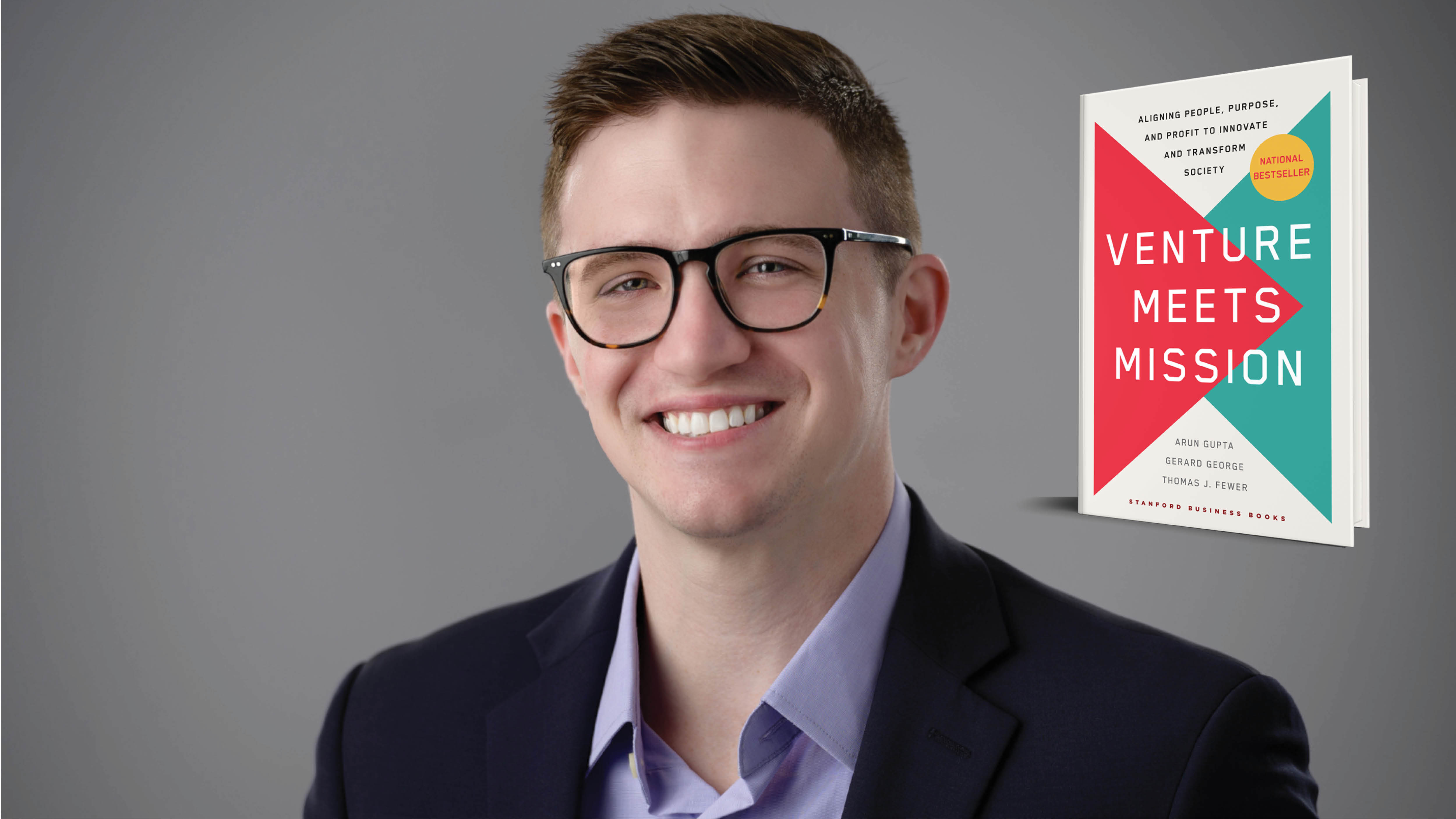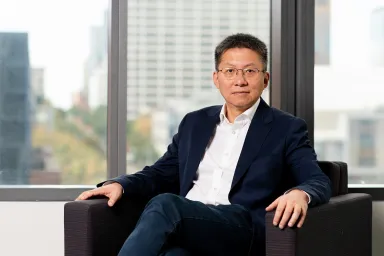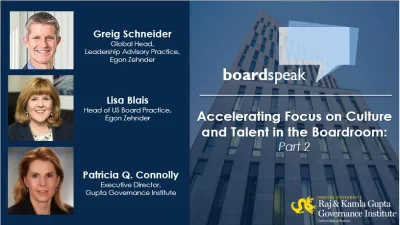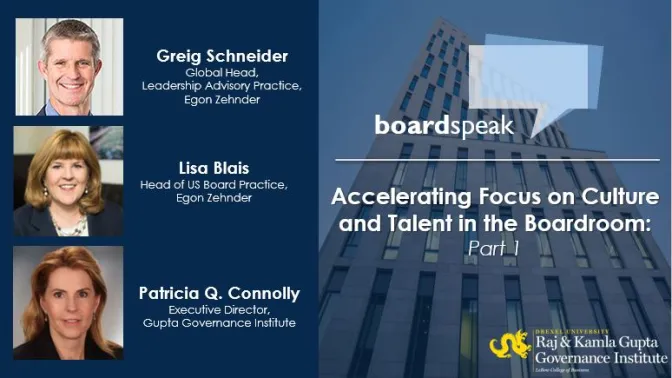
Turning a Vision for Government-Industry Collaboration Into Action
After writing a dissertation on political polarization and its effect on businesses, Thomas Fewer, PhD ‘21, headed to Washington, D.C., a place that, to many, exemplifies government dysfunction. Rather than becoming mired in political debates and gridlock, Fewer tapped into a more optimistic vision for government and the public good that is laid out in “Venture Meets Mission: Aligning People, Purpose and Profit to Innovate and Transform Society,” published in January by Stanford University Press and which debuted at #11 on USA Today’s National Bestselling booklist.
Co-authored with Arun Gupta, CEO of NobleReach Foundation and former venture capitalist, and Gerard George, Tamsen and Michael Brown Family Professor of Entrepreneurship and Innovation at Georgetown University, the book presents a model for connecting start-ups and mission-driven companies with government agencies and creating partnerships in order to solve current major challenges and ones that will arise in the future.
Fewer credits his dissertation advisor Dali Ma, PhD, associate professor and department head of Management, with providing the foundation for his current work: “He really encouraged me to be creative and to follow my own path.”
Now as vice president of talent programs and partnerships at the NobleReach Foundation, Fewer is building on the book’s framework for collaboration between start-ups and government. “We’re looking to be the connective tissue between academic institutions, government agencies and mission-driven organizations more generally,” he says.
In this Q&A, Fewer shares his path since completing his doctorate, what he learned in the process of working on the book and how current college students can learn about and explore careers at the intersection of government and technology.
How did you first become aware or interested in this intersection?
I’ve always been passionate about politics, and in business schools I feel there’s kind of a gap in looking at how business interfaces with political institutions. I wrote my dissertation on political polarization and its effects on the private sector, which got me started in this area, then I moved to Georgetown as a post-doctoral researcher, and with my colleague there, we built on that prior work by looking at the positives of business and government coming together. We wrote about how these two kinds of major entities could come together to address grand challenges, from climate change to cybersecurity.
Eventually, we started talking to a former VC who was investing in the gov-tech space. He saw ventures coming out of Washington or out of Silicon Valley that were working with the government on incredible cutting-edge technology. We found ventures that were targeting the government as the end-user of the product or service and thought it was fascinating. The research on public-private partnerships tends to assume ‘big government’ working with ‘big business.’ But we know that ventures function differently from corporates and have different risk profiles, timelines, and incentive structures. We saw that there’s a gap in understanding of how government works with ventures and entrepreneurs. And right now, we’re seeing tons of momentum behind this type of arrangement, like the Inflation Reduction Act and the CHIPS Act, which are based on models of decentralized innovation: trying to spur innovation from the bottom up. So, the message of the book is very timely.
How did your time at LeBow prepare you for this work?
The thing about LeBow that was important to me is that I was free to pursue the things that I found to be intellectually fascinating. For a long time, LeBow has been pushing for societal impact in research and in teaching. That still resonates with me as I’m working on projects that reach well beyond the academic community. From a research and instruction training perspective, I felt incredibly well-prepared to drive projects as an independent researcher and to handle a classroom.
What’s been your path since completing your doctorate at LeBow?
I took a bit of an unconventional path after I went for the post-doc. Like most post-docs I was convinced I wanted to be an academic. But while I was on the academic job market and interviewing for jobs, my co-author, Arun Gupta, was sitting on the board of Logistics Management Institute (LMI). They were going through a rebranding, and we had just written this book about rejuvenating the national innovation system from a talent and tech perspective. LMI rebranded as the NobleReach Foundation, essentially taking what we wrote about and making it happen with a nearly half-a-billion dollar endowment. Arun was asked to lead NobleReach, and he approached me about coming to the Foundation to help build out some of these programs. And while I was fortunate to receive tenure-track job offers, the opportunity to turn an idea into impact was too exciting for me to turn down. As an academic, a lot of thinking happens at the abstract level and you let practitioners mobilize behind it, but doing this — taking an idea from the conceptual phase to actually building it — has been an amazing experience.
What was the most rewarding or satisfying part of working on this book, and why?
As I was researching and digging into different sources during the writing process, I found my own stereotypes about government being challenged. In order to create a generation of entrepreneurs that are willing to work with government or whose products or services might benefit the public good, we have to confront these underlying biases about both entrepreneurs and government.
We live in an age where government gets conflated with politics. People see on the news how politicians don’t get along and don’t get anything done, and they think that’s what government is: that it’s slow and bureaucratic and that it’s holding society back. In the book, we talked to many people who work in government and who have dedicated their lives to public service. These people live the mission. And their work isn’t seen when things go well — only when it doesn’t. I learned they’re working on some of the most cutting-edge stuff possible, even though there’s a perception of government as slow and inefficient. But you quickly learn how innovative the government actually is. For example, every part of the iPhone that makes it a smartphone was funded by the government of the United States.
There were all kinds of crazy political dynamics over the last two years, and it was hard to separate what’s government from what’s politics. Dealing with that, and confronting my own biases, was a transformative experience for me.
Why should current students consider mission-driven ventures early in their careers?
We’ve seen that this generation is really looking for purpose in their work. We make the argument in the book that after events like the COVID-19 pandemic, the war in Ukraine, and the existential threat of climate change, they’re looking for meaning in their work, for opportunities to move around and gain experience and for ways to preserve the ideals of democracy. Mission-driven ventures, and the government-tech sector more broadly, provide an opportunity to check those boxes. They can work on the cutting edge of technology that has the potential to scale up and affect millions, (if not billions,) of people, and they can also do well for themselves financially while doing good for society. And taking a job in this “mission ecosystem” is much less risky than most students realize. Career paths like consulting are often seen among peers as more prestigious, but they are much riskier. I recently read that if you go to work for a consulting firm, you only have around a 33 percent chance of surviving the first three years, which is way riskier than going to work for a startup.
Think of it this way, too: SpaceX is the biggest mission-driven organization in existence, and it was a startup once, too. If you’re able to get in on the ground floor of a project like that, then the sky is the limit with impact (and profit).
How can students identify what a good opportunity looks like at this intersection?
There are a lot of resources at Drexel, between working with faculty on research funded by federal grants, Drexel Applied Innovation (formerly the Office of Technology Transfer and Commercialization) and various alumni networks. Also, students should check out what we’re doing at NobleReach: We’ve created an internship program that’s focused on experiential learning and this summer, we’re launching a scholars program where students receive one- or two-year fellowships in a government agency. We’re also placing students with mission-driven startups, where there’s a critical need for top talent coming out of the business school. We’ve seen a lot of agencies and academic institutions that are interested, and we’re really optimistic about how we can address these systemic issues.



